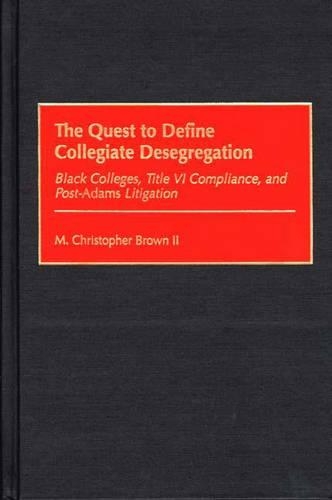
The Quest to Define Collegiate Desegregation: Black Colleges, Title VI Compliance, and Post-Adams Litigation
(Hardback)
Publishing Details
The Quest to Define Collegiate Desegregation: Black Colleges, Title VI Compliance, and Post-Adams Litigation
By (Author) M. Christopher Brown
Bloomsbury Publishing PLC
Praeger Publishers Inc
30th May 1999
United States
Classifications
Tertiary Education
Non Fiction
Higher education, tertiary education
Philosophy and theory of education
Social law and Medical law
Citizenship and nationality law
378.198296
Physical Properties
Hardback
192
Description
In 1954, the United States Supreme Court's ruling in Brown v. Board of Education Topeka (347 U.S. 483) overturned the prevailing doctrine of separate but equal introduced by Plessy v. Ferguson (163 U.S. 537) fifty-eight years prior. By the time Brown was decided, many states had created dual collegiate structures of public education, most of which operated exclusively for Caucasians in one system and African Americans in the other. Although Brown focused national attention on desegregation in primary and secondary public education, the issue of disestablishing dual systems of public higher education would come to the forefront two years later in Florida ex rel. Hawkins v. Board of Control (350 U.S. 413 [1956]). However, the pressure to dismantle dual systems of public education was not extended to higher education until the passage of the Civil Rights Act of 1964. Despite Title VI of this Act, which stated that No person in the United States shall, on the ground of race, color, or national origin, be excluded from participation in, or be denied the benefits of, or be subjected to discrimination under any program or activity receiving Federal financial assistance, nineteen states continued to operate dual systems of public higher education. The Quest to Define Collegiate Desegregation explores the evolution of the legal standard for collegiate desegregation after Adams v. Richardson (351 F2d 636 [D.C. Cir. 1972]).
Reviews
"[Brown's] exacting analysis introduces a new lexicon, indeed refreshing dialogue on the myriad complexities of the legal standards of higher education compliance. Professor Brown speaks to the notion that desegration entails far more than race mixing, especially when the 'remedy' simply creates contemporary renditions of inequity and lack of parity. We have waited far too long for such a clear voice and perspective on an issue so vital to the future of American society."-Carol Camp Yeakey Professor of Urban Politics and Policy Curry School of Education, University of Virginia
"I recommend this book highly not only for its historical value but also for the role it plays in helping us to understand better what the meaning of 'college desegregation' should be in an increasingly diverse society."-Antoine M. Garibaldi, Ph.D. Provost and Chief Academic Officer Howard University
Brown's book is a step in the right direction toward defining the issues.-Multicultural Review
Professor Brown does an excellent job demonstrating the significance of black universities and colleges.-The Law and Politics Book Review
"Brown's book is a step in the right direction toward defining the issues."-Multicultural Review
"Professor Brown does an excellent job demonstrating the significance of black universities and colleges."-The Law and Politics Book Review
Author Bio
M. CHRISTOPHER BROWN II is Assistant Professor of Higher Education in the Department of Educational Organization and Leadership at the University of Illinois at Urbana-Champaign./e Professor Brown has published in the areas of equity and access in postsecondary education.
